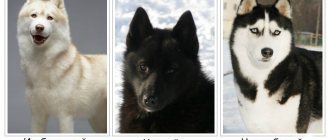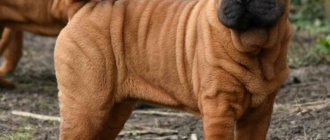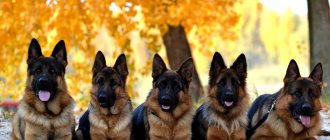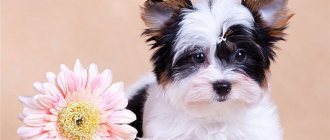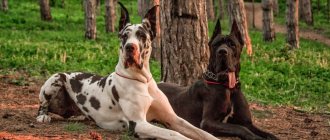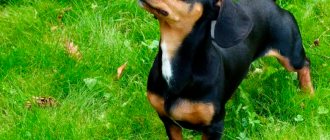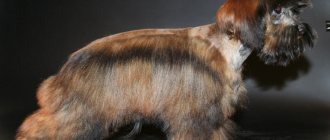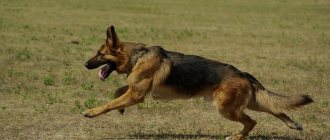French bulldogs are fighting dogs with a multifaceted character, lively temperament and memorable appearance.
They differ from other breeds in their muscular and prominent physique with small dimensions, as well as a variety of coat colors.
French bulldogs have high intelligence and good health; they are excellent protectors and companions, capable of largely copying the character of their owner.
In this article you will learn about the most common types of French bulldog colors and see pictures and photographs with examples of them.
History of the breed
This dog breed owes its origin to English and Spanish bulldogs (Alans) and was bred in the mid-18th century in England.
The appearance of the breed is associated with the widespread dog fighting of that period and the need to breed a small fighting dog. However, French bulldogs quickly emerged from the ranks of similar breeds and became popular among English society as pets, rat-catchers and companions.
The dogs easily endured transportation by hand, which led to their migration from England to France, where bulldogs could only be purchased by members of the French elite. The breed was registered in France, and the first presentation of dogs at an exhibition dates back to 1896.
NOTE!
After recognition by the European Canine Federation, French bulldogs began to appear in America as one of the most expensive breeds (the price per puppy ranged from 550 to 5000 dollars).
In the 20th century, dogs spread into elite circles in Russia, gaining the status of prestigious and fashionable pets.
During the Great Patriotic War, the breed almost disappeared from the country, spreading again after 1950 as an ornamental breed, ceasing to be considered a hunting type dog.
Choosing a puppy
In general, the color of a French bulldog does not affect the character, health, care, or maintenance . Therefore, if a dog is purchased as a pet, a little friend, then you can choose any color that you like.
Today, one of the most popular options is a blue French bulldog puppy with blue, almost blue, eyes. It looks unusual and original, although it was not recognized by the International Canine Federation. Another non-standard, very impressive looking white French bulldog, which also does not meet the standard.
If we are talking about a pet with which the owner plans to win prizes at exhibitions, then in this situation it is necessary to take a serious approach to choosing a “Frenchman”. Before purchasing, you should definitely study the pedigree and find out the coat color of the parents. But such dogs are much more expensive than those that do not meet the standard.
In any case, by purchasing a “Frenchman”, the owner will receive a loyal and reliable friend, another family member. This breed of dog is distinguished by its devotion and tenderness towards its owners.
Character of dogs
French bulldogs are distinguished by their pronounced ability to adopt the personality traits of their owners.
General characteristics of the breed :
- mobility;
- physical endurance;
- intelligence.
Dogs of this breed are trainable , but they learn slowly.
The French Bulldog is unobtrusive, but does not tolerate loneliness well, and by temperament is a companion dog. Representatives of the breed have a highly developed maternal instinct.
IMPORTANT!
French bulldogs have a calm disposition, but they need good upbringing; in the absence of it, they can show aggression both towards other animals and people, and towards members of their own family.
Animal character
The character of the black “Frenchman” is absolutely the same as that of his brothers of other colors.
This breed is quite controversial.
On the one hand, the French are quite lazy and imposing and will gladly keep their owner company on the sofa. On the other hand, puppies are distinguished by their activity and playfulness, which in most cases continues into adulthood.
French bulldogs are distinguished by their excellent intelligence . The dog understands its owner well and is prone to empathy. However, they are not always obedient.
Sometimes you have to repeat a command more than a dozen times for your pet to deign to carry it out. This is due to willfulness and unwillingness to obey.
Although, as dog handlers note, Frenchies are quite amenable to training , but mastering commands will require a lot of effort and patience .
Also, do not forget that dogs of this breed can have different temperaments. For example, choleric people quickly get tired of the training process and begin to shirk.
Phlegmatic people need to be worked at a calm pace. But for sanguine and melancholic people, it is recommended to turn the training process into a fun game.
French Bulldogs are extremely friendly.
They are not at all averse to interacting with small children, and their easygoing nature makes them an excellent friend for your son or daughter, because you can be sure that the dog will not attack them or decide to go AWOL during a walk.
French bulldog colors
The breed standard allows the following colors:
- brindle;
- spotted;
- pale yellow.
The remaining colors (white with black spots, mouse, smoky, liver, blue, tan, pure black) are defective, which does not affect their popularity among connoisseurs of the breed.
The most common colors are white, blue, fawn and brindle.
Below you can see descriptions of what this or that color looks like, as well as photos with examples.
White
Purely white color is extremely rare.
As a rule, the color is represented by snow-white or milky-white shades. The spots on the dog's body can be any color (but not black), and there is often a dark mask on the face. This color is genetically recessive.
Representatives of the white coloration have good immunity.
Gray
Gray coat color is widespread.
The color is represented by gray shades of varying degrees of severity (from light gray to metallic), monophonic. The coat is short, shiny, and the hairs are the same gray color throughout.
Dogs may have small white spots on the chest (but most often there are no spots or a mask).
Redheads
The red color is a common variation of the fawn color.
Dogs have a black mask on their face. The wool is uniformly colored in a rich copper-red shade. White spots are allowed on the puppy's body, except for the chest, neck and belly.
Blue
Blue Bulldogs have not been recognized as a standard color, but are becoming increasingly popular.
Blue coat color is a variation of gray and comes in various shades, but the most common is “blue clay color.” Often this beautiful color is combined with blue eyes.
This color is monochromatic, but puppies may have small spots of white on the chest.
Black
Black coat color is not a single color - in fact, dogs have variegated colors of varying degrees of intensity (variations of dark brown, brown and tan, black and tan). The intensity of the shade depends on the genetic characteristics of the dog.
Beige
The beige color of the breed was recognized as standard only in America.
NOTE!
The beige color is similar to the fawn color, but differs from it in the different coloring of the tip of the nose, eyelids and lips of the dog. When they are beige they are cream in color, while when they are fawn they are black.
Beige representatives do not have a black mask and are born light red (evening out and lightening the tone to beige occurs gradually).
Chocolate
Chocolate color is a uniform, rich brown or brown-brown color with a slight shine. Variations in shade are possible, but it will always be monochromatic.
Chocolate-colored dogs have longitudinal white spots on the neck and belly, and there is no mask on the face.
Merle color
Merle (merle) is a marbled coat color. It is a genetically dominant trait and is not recognized as a standard.
Merle coloring is uneven, tricolor and is represented by fuzzy spots of various sizes and shades, most often alternating coffee, white and brown. There is usually no mask.
Often representatives of this color have heterochromia (different colors of the iris), as well as other genetic abnormalities.
Brindle
Brindle is the most common color. It is represented by a variegated alternation of red and black stripes on the dog’s body. Light (“milky”) markings are allowed on the chest and neck; there is a dark mask on the muzzle.
Brindle color is inherited as a dominant trait. Puppies with this coloring are distinguished by good health, mobility and unpretentiousness.
Fawn
The fawn color is represented by a rich range of colors from light coffee to red. Within each color there can be both light and dark fawn shades.
A fawn colored dog may have a dark mask or a small number of small white patches on the chest and neck. The belly is white.
With this color, the hairs have a red color of varying degrees of intensity and length. Short ones are lighter, long ones are darker. The tips of the hairs are often gray in color.
Any variation of fawn color must be uniform. Fawn color can be either recessive or dominant. Varieties: fawn brindle (fawn color dominates) and variegated fawn (black color dominates).
What do newborn puppies look like?
Newborn puppies, regardless of gender, weigh from 190 to 350 grams. The head is large, occupies up to a third of the body length (6-7 cm), the nose is black, moist, short and upturned, the nostrils are wide.
The puppy's eyes are set wide apart, the eyelids are tightly closed (puppies are born blind). The oral mucosa is light pink. The puppy's front paws are straight, the pasterns are strong, and the paws are not splayed.
The belly of a newborn puppy is rounded, but not swollen, soft and has a small layer of fat that is gathered into a fold with two fingers. The anal area is light pink. The tail is short, broken, can be curved, and is never located above the line of the back.
The fur of newborn puppies is smooth, velvety and shiny.
IMPORTANT!
Representatives of non-standard colors may have various genetic abnormalities and are more demanding in care and nutrition.
How do puppies change as they age?
At 1 month, puppies rapidly gain body weight and have a large appetite. After the eyes open, you should make sure that their irises are the same color.
Puppies are agile and slightly clumsy; by the end of the first month of life they reach a weight of 1-1.5 kg.
At 2 months, puppies learn to stand on their hind legs with emphasis on a hard surface, playful and funny. During this period, their ears become fully erect, the spots on their body become more distinct, their weight reaches 2.5 kg, and the puppies begin to remember their name.
At 3 months, the replacement of baby teeth (incisors) begins, skin folds become more noticeable, and weight reaches 3-5 kg.
From 4 months, fangs are replaced, and increased growth of tubular (long) bones begins. From this month, puppies begin to toilet train or ask to go for a walk , weight ranges from 4 to 6 kg (girls are usually smaller than boys).
At 5 months, the puppy’s small molars are replaced, muscle mass is gained, and the weight reaches 7-8 kg.
At 6 months, males weigh up to 10 kg, females - up to 8-9 kg, the rate of weight gain increases by 2.5-3 times , the height at the withers reaches 35-37 cm.
At 7-8 months, the change of teeth is completed, the growth of tubular bones slows down, the muscle relief is clearly visible, the mask on the muzzle is clearly visible, and the weight reaches 12 kg.
At 9 months, puppies are actively exploring the world around them, are able to remember and follow commands, are trainable, and weigh up to 13 kg.
From the 10th month, the jaw is maximally developed, the bite is fully formed, and the weight is 14-16 kg.
At 11-12 months, puppies gradually approach the appearance of an adult dog:
- folds and color are well defined;
- all muscles are developed;
- the back is strong;
- cylindrical chest;
- The dog is active and physically strong.
The weight of a puppy of eleven to twelve months reaches 15 kg.
Read more information about the weight of French bulldogs here.
Which color should I choose?
The French Bulldog has many standard and non-standard color types. The choice of color depends on the purpose for which the breed is purchased.
Dogs that are bred to participate in exhibitions and achieve champion status must have a standard color (for example, brindle). A dog with a non-standard color is considered a defect and will never become a champion. Additionally, a dog's color can have an impact on its genetic health.
NOTE!
Some types of color are genetically linked to various anomalies of the iris, bite, vision and hearing (blue, mouse color).
The color of the coat also affects the price of the breed - puppies of a standard color are much more expensive.
Colors
There are many different colors. A fan of this species will easily find exactly what he wants.
Colors are strictly divided into standard (acceptable) and non-standard (prohibition on participation in exhibitions and any competitions and competitions).
Briefly, prohibited colors include:
- Blue and mixed, which contains this color.
- Chocolate and mixed including it.
- Tricolor.
French bulldog blue color
A wonderful combination: gray with a bluish tint! Beautiful, rich color. As a rule, a blue puppy has a wide white stripe running from the chin along the neck, looking like a kind of “collar”.
However, this wonderful color is not canon and, according to official documents of the FCI (International Cynological Federation, which determines standards and much more), pets are considered defective . Of course, this has absolutely no effect on behavior or other characteristics. A dog like this can become a true friend! But entry to various exhibitions is closed.
French bulldog black color
It is worth noting that absolutely black simply does not exist in nature. There are so-called tiger-black ones, their fur has not too pronounced reddish stripes.
Many people breed just like this. “Tigers” have always been in good demand. Black and brindle coloring is not disqualifying.
There is also a simple brindle coloration, when there is approximately equal amount of dark and red, and this is also very popular.
White French bulldog
Light individuals are a classic. These can often be found on the streets of the city. All shades listed below are recognized by the FCI .
Among them there are some animals that are completely white, without spots, blotches, or anything else.
Whites with black spots are allowed, but the light ones occupy the main area. This is called spotted coloring.
White brindle is characterized by sparse dark spots. Most of the mouth and forehead in this case are brindle.
Fawn, tan to coffee brown. It was declared the main one only in 1995.
Mixtures between the main colors are allowed and are not considered a defect.

